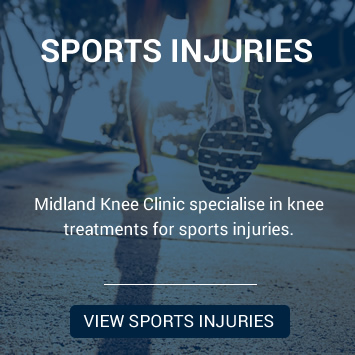Bone Marrow Stimulation or Microfracture
This is a low cost technique for treating smaller areas of cartilage damage. The procedure is normally carried out at arthroscopy. The defect (or lesion) in the cartilage is assessed. The unstable cartilage at the edge of the defect is trimmed to a stable edge with hand tools and motorised shavers. This leaves a regular defect in the cartilage that is better able to contain the repair tissue.
A cartilage lesion that has had the edge stabilised with abrasion chondroplasty

The operation
A small sharp “pick” is passed into the knee through one of the arthroscopy portals and used to penetrate the “subchondral plate” at the base of the cartilage defect. The subchondral plate is the layer of tissue between the cartilage and the bone. Cells are released from the marrow of the bone through a number of perforations into the subchondral plate. The intention is for these cells to settle into a blood clot that develops at the site of the defect. This becomes the repair tissue.
The cells released from the bone marrow are called “mesenchymal stem cells”. This means that they have the ability to transform into other types of cell – namely, cartilage cells (chondrocytes). It seems that they actually probably develop into fibrochondrocytes and that a “scar- form” of cartilage is produced rather than true cartilage. This “scar” cartilage is termed fibrocartilage whereas true articular cartilage is called “hyaline” cartilage. The main difference between the two types is that hyaline cartilage contains more type II collagen.
After the operation
It is crucial that a proper post-operative rehabilitation is maintained.
If the lesion that was treated was on the femur (the thigh bone side of the knee) it is important to limit movement in the knee from fully straight to a maximum of 60 degrees bending within a brace.
If the lesion that was treated was in the knee-cap joint (patellofemoral joint) then movement in the knee should be limited from fully straight to a maximum of 45 degrees bending within a brace.
Frequent movement of the knee will improve the nutrition of the cartilage as it forms in the defect and also encourage the marrow cells to form into cartilage type cells. The movements in the knee should be carried out either with a continuous passive motion machine or by ensuring that non-weight-bearing movements are carried out by the patient frequently. It is estimated that the full arc of movement allowed within the knee should be moved more than 1500 times per day!
Outcome of Microfracture
The outcome of surgery is varaiable from case to case. Studies have demonstrated that the level of pain improvement; the ability of the patient to return to sport and the restoration to full function of the knee depend on several factors:-
1) Smaller areas of damage do better
2) Younger patients do better
3) If the patient has had a short period of time between injury and surgery the outcome is better
4) If the patient has not undergone many operations to the knee prior to the microfracture procedure the outcome is better.
About 75% of professional athletes are able to return to their sports after this procedure. However, it seems that the results deteriorate with time.
The cartilage ulcer from the top, – 1 year later after microfracture

Autologous Osteochondral Transplantation and Synthetic Osteochondral Plugs
This is a method for treating defects within the articular cartilage.
This technique involves using short cylindrical plugs to replace the defect in the cartilage. The term “osteochondral” means that one end of the cylinder is bone and the other end is cartilage. If the cylinders of tissue are “autologous” this means that they are taken from the patient’s own knee. This tissue must be taken from an area of the joint that is not required for articulation – such as just to the side of the knee-cap joint (patellofemoral joint).
The alternative to using autologous tissue is to use a synthetic tissue instead. This is a fairly new technique but the short-term results are good. The synthetic patch is a collagen scaffolds that is intended to allow the patient’s own tissue to grow into it. The benefit of using these instead of the patient’s own cartilage is that the trauma to the patient’s knee is reduced by not having to obtain the graft from it. This technique is a particularly good option if the cartilage defect extends into the superficial bone as it allows grafting of this area too.
A third option is to use cadaveric graft from a deceased person’s knee. This is not presently commonly carried out in the UK. This is due to its high cost; limited graft availability; potential for disease transmission; and difficulties in sizing and machining the graft tissue.
Outcome of osteochondral transplant
The results depend on the site of the cartilage defect. Research has identified that treatment for lesions of the femur have better results than those of the tibia, which in turn do better than lesions of the patella. 3% of people having autologous transplantation have problems with the area the cartilage was taken from (the donor site). Good results are reported in 80-90% of knees in most publishes series.




